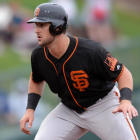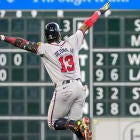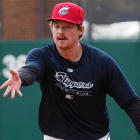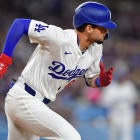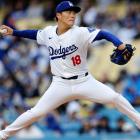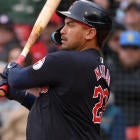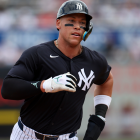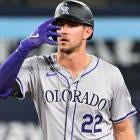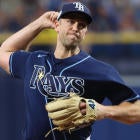When assessing prospects, it isn't all about upside. You're also weighing downside, utility, pliability, timetable ... so many factors.
But upside is the most fun of them all. And the first question in today's prospect mailbag wonders which ones have the most of it.
Who are 10 prospects not named Wander Franco that have the ceiling to be the #1 prospect in baseball in due time?
— D (@SB26364849932) April 16, 2020
(Thinking along the lines of Abrams, J-Rod, Puason, etc. Guys like Adley and Bohm, albeit excellent prospects, don’t have quite that ceiling).
I never like to put limits on upside — not for players so young, anyway. Too many of the best in the game today were at one point thought to be small potatoes. Mookie Betts, Paul Goldschmidt, Jose Ramirez and Jacob deGrom come to mind as players whose greatness wasn't immediately recognized, but even Ronald Acuna wasn't some high-dollar international signing when he first latched on with the Braves.
That's not to say I'm opposed to taking part in this exercise because it's a useful one. But when playing the speculation game, I normally don't speak in such definite terms.
Normally for this exercise, prospects who play a more premium defensive position have a distinct advantage, which I guess makes sense. It's an additional skills threshold that's being met, and a capable shortstop could conceivably play anywhere, giving him a wider path to success. Still, it's weird to look back and see that a guy like Joey Votto was never more than, like, the No. 40 overall prospect.
Presumably, prospects like Luis Robert, Jesus Luzardo, Gavin Lux and Dylan Carlson will have graduated by the time there's another round of preseason rankings, so I see no reason to consider them. I'm also not putting much stock yet in a 17-year-old just signed off the international market, meaning Robert Puason (among others) is out. He's too much of a blank slate at that point, making any assessments of his potential hazy at best.
I will stick my neck out for one, though: Yankees outfielder Jasson Dominguez, who already produces elite exit velocities from both sides of the plate and some scouts have called the best international prospect they've ever seen. Looking more immediately, Angels outfielder Jo Adell is a given, provided he doesn't graduate first. Mariners outfielders Jarred Kelenic and Julio Rodriguez also fit the bill, with the latter being more likely just because he's younger.
I agree that Padres shortstop C.J. Abrams could be in the discussion if there proves to be enough power in his bat, though Royals shortstop Bobby Witt, the second overall pick in this past year's draft, is an even more likely choice. Marco Luciano, a member of the previous international class, showed serious offensive potential low in the Giants system last year, and Braves outfielder Cristian Pache doesn't seem totally far-fetched if he makes a big leap offensively this year (or whenever he's playing again).
I actually would put Adley Rutschman, the top overall pick last year, in this group. Catchers have longer odds for reaching the top spot in the prospect rankings, but two of the best in recent memory, Joe Mauer and Matt Wieters, managed to do it. Rutschman would seem to be another of their ilk.
How do you prefer to use your last few minor league spots in dynasty? Guys who are about one year a way who could contribute but have limited upside or guys who are 3-4 years away who could be really valuable if it all comes together for them?
— Zachary Blain (@Zachman285) April 21, 2020
I don't really think of it in terms of "first few spots" and "last few spots," nor do I divide players by timetable. It's just another variable to consider — one that I may weigh more than others but one that's partly contingent on league size and how fully stocked my big-league roster already is. A shallower league or a fully-stocked roster would encourage me to take bigger swings.
But speaking more generally, I do value timetable for the reasons partly addressed in the previous question. The further away a prospect is, the more uncertain his outcomes are. Every minor-league level represents another opportunity to stumble, and every hurdles he clears, whether by continuing to produce or by maintaining a high prospect standing, puts him one step closer to being a worthwhile major-leaguer.
And that's the biggest hurdle of all. If you're looking to sustain success in a dynasty league, the easiest way is by actually hitting on your minor-league picks. And yes, a "miss" can mean different things in different leagues, but a prospect who never amounts to anything is a miss across the board.
Besides, simply reaching the majors unlocks a new range of possibilities. It's not uncommon for players to make their biggest leap at that level, as we saw with Austin Meadows last year. And I'll point out that Shane Bieber and Luis Castillo were never of a particularly high prospect standing.
One other perk to thinking near-term: Every time you graduate a prospect, you get a chance to take a stab at another, and opportunities might be the most valuable resource when prospect hunting. Turning them over quicker increases your chances of hitting big on one.
What's the ceiling and floor for McKenzie Gore?
— Steven Falkenhagen (@StevenFalk) April 16, 2020
Well, he was selected third overall straight out of high school, with many at the time considering him the best player in his draft class, and is regarded as the best pitching prospect in baseball despite only barely reaching Double-A. So yeah, I'd say MacKenzie Gore's ceiling is the best pitcher in baseball.
He has a deceptive delivery featuring a big leg kick and the sort of extension that allows his fastball to sneak up on hitters. All four of his pitches rate as plus, including two breaking balls, and his command of them is top notch. I'd say he's like a left-handed Walker Buehler, but the truth is he has even more going for him.
So what's the downside? An interesting question. He could of course need something like thoracic outlet syndrome early in his career and never be the same, but presuming good health, I have a difficult time envisioning Gore as less than a Fantasy ace. Even if the Padres play it extra cautiously with him, never allowing him to go past six innings, he's, what, Blake Snell with better control? And it's not like Snell isn't being drafted as an ace.
That's not to say Gore is foolproof. Health issues have brought down many a talented pitcher. But from where he stands today, the ceiling and floor are both about as high as they could be.
Are we about to see a surge in fantasy capable catchers w guys like bart and rutchsman rising up the minors? Also you have smith looking to make a big leap this season, add that to the guys just hitting their prime it seems like 6-8 could be fantasy assets in the next few years
— Ryan Lapointe (@lapointee71) April 21, 2020
Prospects often don't end up where they start out, but rarely do you see one transition to catcher. And yet it's such a critical position. By necessity, then — the fact an organization needs a certain number and that they can't be converted down the line — the position is never lacking in talent. It's just that so many catchers end up short-circuiting somewhere along the way.
Aside from pitcher, it's the most demanding position physically and mentally, and both can hinder a catcher's development as a hitter. Matt Wieters, who I noted earlier was at one time the top prospect in baseball, never developed into the hitting stud he was expected to be. He still mattered in Fantasy because the threshold for a catcher mattering is low. But the threshold for one being a significant asset that people pay up for? That's high. The fact is, particularly in one-catcher leagues, we're never forced to reach that deep into the catcher pool.
So while we may think of Adley Rutschman, the first overall pick last year, and Joey Bart, the second overall pick in 2018, as can't-miss, it's possible they don't reach that high-end threshold. Still, it's rare to have two catcher prospects that are so high-end at the same time, improving the odds that we get at least one stud out of this prospect crop. It's also possible that the Padres' Luis Campusano or the Diamondbacks' Daulton Varsho could break out in that way. Or maybe it's someone who was overlooked for years, like a Mitch Garver. There will be some who break out at the position. There always are.
But the attrition rate among catchers is so high that I think the chances of something revolutionary happening at the position, like we've seen at shortstop in recent years, is low.
Given the jorge polanco contract extension, what do you see the twins doing with royce lewis? Seemed like a cant miss guy, and now hes blocked for at least 4 years.
— Cards⚾️ Pack🏈 Bulls🏀 (@tedgehman0819) April 21, 2020
I've wondered this myself, just because you can't help but wonder, but to borrow a line from Jurassic Park, life, uh, finds a way.
It's easier than ever now with versatility becoming almost prerequisite for all but the most slow-footed. Luis Arraez, the Twins' 23-year-old second baseman, has already shown the ability to play third base and the outfield, so it's possible he could transition to a super utility role, opening up second base for Jorge Polanco. It's not like Polanco is some defensive standout at shortstop, and he has manned second base before. Or maybe Polanco himself is the one who transitions to the super utility role. Shoot, Royce Lewis himself played mostly third base and center field in the Arizona Fall League, so it's possible shortstop isn't even his ultimate destination. It probably depends how the next couple years go for all three.
And I want to stress the next couple years part. I don't personally foresee Lewis reaching the majors until some point in 2021 (or maybe 2022 if this season is canceled). He's still only 20 and had a bumpy ride in his first taste of the upper minors last year, batting .236 with a .661 OPS. Few evaluators seem too concerned about it because he's a former No. 1 overall pick and had performed well up to that point, but barring an injury at the big-league level, there's just no reason to rush him.
So much can happen during that time. Maybe Josh Donaldson collapses and Polanco is needed at third base. Maybe Miguel Sano collapses and someone is needed at first. Maybe a big trade goes down. Maybe Lewis' struggles last year indeed become the norm and his stock plummets. Whatever the case, life will find a way.
Can Joe Ryan find space in the crowded Ray's future rotation
— Isaac Klein (@IsaacKlein17) April 21, 2020
What did I say about life finding a way?
OK, this situation is a little more complicated because Joe Ryan is already 23 and had a 1.96 ERA, 0.84 WHIP and 13.3 K/9 between three levels last year, ending at Double-A. He's more definitively "knocking on the door," then, and sooner than later, the Rays will want to let him in.
What complicates his situation isn't just that the Rays currently have a rotation surplus, looking to fit fellow prospect Brendan McKay into a group that already includes Charlie Morton, Blake Snell, Tyler Glasnow, Yonny Chirinos and Ryan Yarbrough. There's also a chance Trevor Richards and Jalen Beeks could be used as starters, and still another prospect, the now-25-year-old Brent Honeywell, will be looking to debut after a couple seasons lost to injury.
But again, it's not just about the surplus for Ryan. That's something every pitching prospect has to deal with on some level, but turnover comes so naturally to a five-man rotation over the course of 162 games that it's rare for any to be held up too long. The bigger impediment to to Ryan's Fantasy value is the Rays' unconventional approach to pitching.
They're good at developing it, sure, but for a prospect who isn't explicitly high-end, like Ryan, the chances of him settling into more of a swingman role in which he's throwing three or four innings at a time seems high. And because he's mostly fastball-changeup, lacking the sort of breaking ball needed to make a third trip through the batting order, it actually might be the perfect role for him.
That's good news for the Rays, but bad news for Ryan's Fantasy value.














